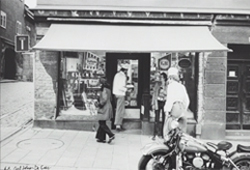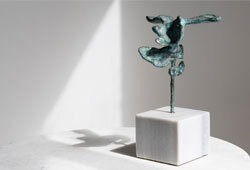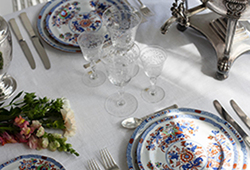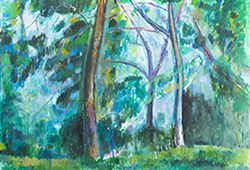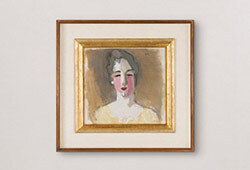Nils von Dardel
"Trappan"
Signed Dardel and dated 1925. Canvas 100 x 80 cm.
Alkuperä - Provenienssi
The artist's wife Thora Dardel (née Klinckowström) (1899-1995).
The artist's daughter Ingrid Ekwall (1922‑1962).
The artist's granddaughter Denise Unger.
Director Söderlund, Kungsholmstorg, Stockholm.
Stockholms Auktionsverk, Quality Auction, 16 - 20 November, 1976, lot. no. 509, depicted in color on the catalog cover.
thence by descent to the present owner.
Näyttelyt
Exposition Nils Dardel, Stockholm, 1925.
L'Exposition universelle de 1935 à Bruxelles (World Exhibition in Brussels), May 24 - November 1935.
Kunstnernes Hus, Oslo, November 1939, cat. no 43.
Liljevalchs konsthall Stockholm, "Nils Dardel - Memorial Exhibition", March 25 - May 1, 1955, cat. no. 195.
Exposition Nils Dardel, Stockholm, 1989.
Muut tiedot
In 1925, Paris was booming and optimistic after the dark years of war. The positive American way of life was in vogue, entertainment was flourishing, theaters and revues were popping up, and new jazz clubs were opening in the neighborhoods. Nils Dardel was 37 and Thora 26, and their Parisian life had reached its peak. Success followed success and social life flourished for both of them. The Scandinavian cultural centre Maison Watteau, run by Swedish sculptress Lena Börjeson, organized classes, exhibitions, and above all, spectacular costume pieces worthy of the 'Roaring Twenties'. It was also a time of disruption and change.
In Montmatre, at the top of Rue Lepic, at No 108, was the studio apartment of Nils and Thora Dardel. It was a charming and picturesque house with no lift. Up four flights of stairs was the residential floor, above it was the large studio, and another flight of stairs led up to the roof terrace. From the height of Montmatre, there was a sweeping view of the whole of Paris. It became a famous address where artists and cultural figures from near and far met. Often they would gather for a drink and then move on to one of the city's bars and restaurants. Thora and Nils Dardel had a large international social circle and their bohemian hospitality was renowned. Rolf de Maré, in the anthology 'Mitt Paris', has given a picture of life in this circle: 'Sometimes the journey went to the Dardels' studio. One could often find his friend Nils in pajamas in front of his easel, even if it were late in the day. But many times it was lively and crowded both in the studio and on the roof terrace. I remember one evening when I came with Isadora Duncan. On Dardel's terrace, we found a motley crew of artists, models and a band of [...] musicians. Nils himself walked around like an amiable, smiling host and Thora Dardel made sure that everyone had a glass in their hand. A curious feature was her daughter Ingrid, who showed her private menagerie of white mice, emerald lizards and snakes."
By 1924, Dardel has become a celebrity. He created his trademark 'Dardel' after being Nils von Dardel or Nils Dardel. He received many commissions, both in Sweden and in Paris, and society, previously appalled by his eccentricity, now queued up to have their portraits painted by the famous Dardel. His marriage to Thora and his daughter Ingrid had given him new weight and legitimacy, and in Paris he exhibited at the Maison Watteau and the Tuileries Salon, where he received much attention. This was followed by the group exhibition 'Falangen' at Liljevalchs in the spring of 1925, and the following year Dardel took part in the Swedish section of the international exhibition in Dresden. The exhibition was shown before departure at the Swedish-French Art Gallery, whose director Gösta Olsson was Dardel's art dealer and representative in Stockholm.
The current painting 'The Staircase' was executed in 1925 during this successful and hectic period. Life in Paris was spinning for many, this lifestyle was both destructive and devastating. In the theatrical painting 'The Staircase', the viewer participates in a silent drama taking place in a winding stairwell. It could be No 108 Rue Lepic. The walls are painted in a warm terracotta colour. On the landing, Thora stands in the doorway, wearing a fashionable straight 1920s dress. In her hand she holds a large fan in ice blue, as if she wants to quickly hide her face. The cold blue color of the fan is repeated and reinforced in the details of the dress. The staircase winds upwards towards the height and freedom of the roof terrace, but Thora seems to be frozen in the doorway. On the floor below, there is a conversation between an elegant dandy in a green jacket and an anonymous woman who seems hesitant about the man's animated conviction. Like an S-shaped movement, the staircase sweeps inexorably up through the drama, interrupted only by the straight vertical bars of the railing. The painting is realistically executed and is completely devoid of the bizarre and imaginative elements that had previously emerged from Dardel's subconscious and found their way into his work. Thora has written: "His whim came quite naturally. He never painted for the sake of painting, but out of an inner need. But he was also amused by the geometry of his compositions, and the occasional monkey was probably there for the same reason as ornamental towers on buildings."
The painting 'Staircase' was previously part of the collection of Thora and Nils Dardel's daughter Ingrid Ekwall. "The Staircase" was exhibited in Stockholm in 1925, at the World Exhibition in Brussels in 1935, Oslo in 1939 and at Liljevalch's "Nils Dardel - Memorial Exhibition" in the spring of 1955.
Photo 1: Thora and Nils in a window in the studio apartment on Rue Lepic, photographed by Harald Klinckowström.
Photo 2: Nils and Thora on the roof terrace of Rue Lepic. National Archives Thora Hamilton's archive 4ae-11 1920






